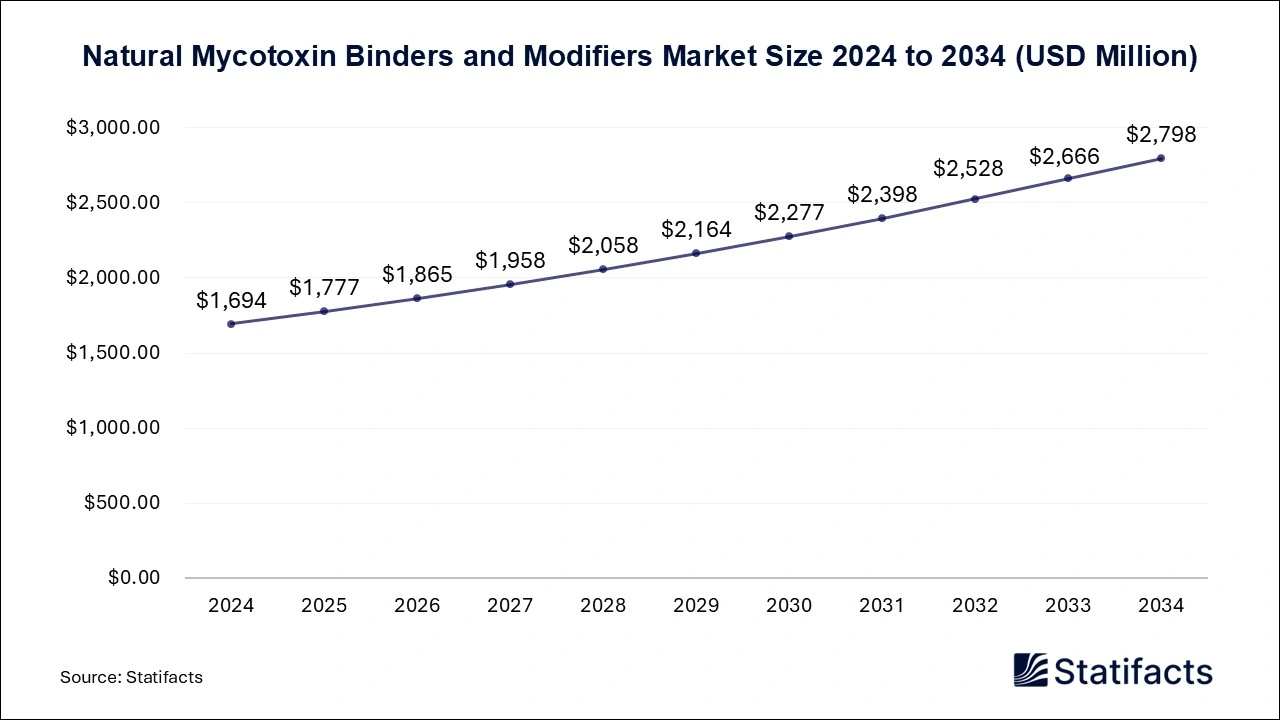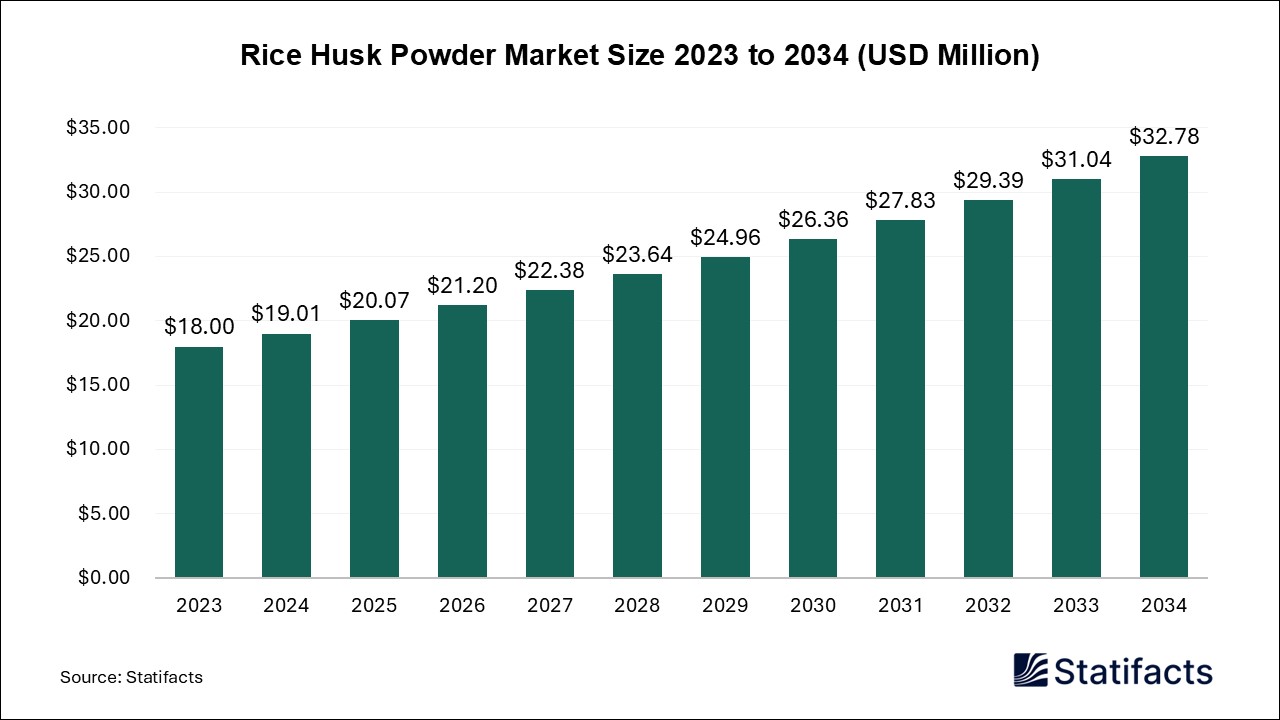Last Updated: 07 Jul 2025
Source: Statifacts
By clicking “Accept All Cookies” you agree to the storing of cookies on your device to enhance site navigation, analyze site usage, and assist in our marketing efforts.
Privacy PolicyU.S. Energy Storage Market (By Source: Plant Extracts and Microbial Fermentation Products; By Region: North America, Europe, Asia Pacific, and LAMEA) Industry Size, Share, Growth, Trends 2025 to 2034
The global natural mycotoxin binders and modifiers market size accounted for USD 1,694 million in 2024 and is predicted to touch around USD 2,798 million by 2034, growing at a CAGR of 5.14% from 2025 to 2034. Rising feed safety awareness, demand for quality meat and livestock products, and sustained shift towards all-natural additives have stimulated the natural mycotoxin binders and modifiers market. Due to advanced farming practices and stringent safety regulations, North America reigns over the market; meanwhile, Asia Pacific is considered the fastest-growing region because of increased livestock farming, feed contamination concerns, and stricter government regulations. Keeping animals safer and achieving global food standards stimulates market growth.

| Reports Attributes | Statistics |
| Market Size in 2024 | USD 1,694 Million |
| Market Size in 2025 | USD 1,777 Million |
| Market Size in 2031 | USD 2,398 Million |
| Market Size by 2034 | USD 2,798 Million |
| CAGR 2025 to 2034 | 5.14% |
| Base Year | 2024 |
| Forecast Period | 2025 to 2034 |
The natural mycotoxin binders and modifiers market studies, develops, produces, and markets binders for companies that attempt to decrease the harmful effects of mycotoxins. Mycotoxins are naturally toxic substances produced by fungi that contaminate ingredients such as grains, cereals, and oilseeds. These binders bind toxins inside the digestive tract of the animals and prevent their absorption, thus diminishing the toxic effects. Modifiers alter the chemical structure of the mycotoxin and render it less toxic or non-toxic. Mycotoxins are responsible for losses to farmers and feed manufacturers through reduced production, diminished toxin resistance, poor reproductive capacity, and death. A growing number of people have developed an awareness of these solutions, alongside stiff regulatory norms, fostering demand for the industry in line with the global growth of animal farming in a sustainable, efficient manner.
AI benefited the natural mycotoxin binder and modifier in many ways. Rather than disrupting all over the place, AI begins to act in implied management of mycotoxins in animal feed by increasing detection and precision and thus efficiency: it processes large quantities of data to predict and assess contamination early for binders' and modifiers' subsequent application in a focused manner; AI also lays down personalized strategies for feeding to conserve resources while minimizing health hazards in animals being raised. In this way, it endorses sustainable agriculture, ensuring less misuse of additives in the environment. Criminally advanced analytics reveal the patterns of contamination to cease it long ways and minimize future risks in support of an environment for healthier livestock and smoother farming operations.
The major market drivers in the natural mycotoxin binders and modifiers market are the increasing prevalence of mycotoxins in crops and, rising demand for livestock products.
The growth of the natural mycotoxin binders and modifiers market is restrained by factors such as in consists inefficiency toxin regulatory concerns.
The natural mycotoxin binders and modifiers market faces issues of efficacy inconsistency, cost of natural ingredients, and the requirement for toxin control at various feed sources. Performance of the binder varies greatly depending on the type of mycotoxin present, the binder's composition, and the species of livestock to be treated. Some binders impede nutritional or digestive functions, i.e., an additional concern for health or performance. Buyers may be concerned with the price of certain natural ingredients such as plant extracts, enzymes, yeast derivatives, or certain clays, which tend to be more than their synthetic counterparts, thus putting money first in their consideration of feed additives for livestock producers, especially small to medium-scale farms or in developing regions. This stands against the common benefits that the natural options provide for humanity and the environment.
The opportunities in the natural mycotoxin binders and modifiers market are associated with rising consumer awareness. The market for natural mycotoxin binders and modifiers is growing as consumer awareness of food safety, animal welfare, and sustainability increases. This demand is felt mostly in developed countries such as North America and Europe due to higher regulatory pressure and expectations. Demand for antibiotic-free meats and dairy further adds to the natural binder market, as these binders aid in maintaining animal health and productivity without affecting food safety. As traceability and transparency become more important in the food supply chain, natural feed additives are going to gather considerable weightage. The livestock industry is fast-paced in emerging markets on account of rising incomes, urbanization, and changing food preferences. Since such climatic conditions and post-action harvest handling serve to foster mycotoxin contamination in these areas, conversely, natural binders may well be adopted as a way out. This provides greater market potential for companies that can provide an efficient yet affordable natural mycotoxin solution on demand, oriented toward local needs and feed systems.
“The state-of-the-art production line is a game changer as it enables us to deliver innovative and valuable solutions to the livestock industry and key players across the value chain for the Asia Pacific market.”
The plant extracts segment dominated the market in 2024 and is expected to grow at the fastest rate during the forecast period. Plant extracts and phytochemicals serve as natural solutions to mycotoxin-related disorders. These act by preventing mycotoxins from being absorbed into the blood by binding and modifying them in the digestive tract. Some plant extracts, like garlic and turmeric, induce the synthesis of detoxifying enzymes that mitigate the toxic effects of mycotoxins. They also work against fungi that are involved in the formation of mycotoxins. Their antioxidant property can additionally compensate for oxidative stress, thus benefiting animal health. In this sense, plant-based solutions impart a multifaceted approach toward rearing feed safety and animal performance. Microbial fermentation products are expected to grow at a notable rate during the forecast period. Products resulting from microbial fermentation are mostly derived from bacteria and fungi and bind or modify mycotoxins in animal feed. Binders, such as yeast cell wall components, perform physical absorption of mycotoxins so that they cannot be absorbed into the body and exert their deleterious effects. Conversely, modifiers, such as microbial enzymes, conduct chemical transformation of mycotoxins into less toxic compounds to protect animal health and performance. Increasing research will probably produce wide-spectrum microbial enzymes with broader protective mechanisms against many types of mycotoxins, hence offering microbial fermentation as a detoxification method of the future.
North America holds the largest share of the natural mycotoxin binders and modifiers market in 2023, owing to advanced agricultural systems coupled with the use of biotechnology, especially in the U.S. and Canada. Large-scale grain production throughout the region and long supply chains increase the risk of mycotoxin contamination, thus binding producers to binders and modifiers. Without international safety standards, the very exports of dairy, meat, and animal products would be threatened. The feed industry is focused on feed free from contamination that has a positive effect on productivity and animal welfare, thereby fueling the demand for mycotoxin control solutions.
Asia-Pacific is expected to be the fastest-growing market for natural mycotoxin binders and modifiers, owing to growing awareness about the harmful effects posed by mycotoxins, which has led to increased use of binders and stricter regulations harmonizing toxin limits in animal feed. These elements, also including the fast growth of the livestock sector, are further accelerating the use of mycotoxin binders and modifiers.
The market is moderately fragmented with local players like Cargill, Chr. Hansen, Bayer, BASF, ADM, Perstorp, etc. wishing to take the time to edge their presence through investments, partnerships, acquisitions, and mergers. They also invest in product development and competitive pricing. These strategies will promote market growth and lucrative opportunities for market players
Cargill's annual revenue for fiscal year 2024 was $160 billion, a decrease of 10% from the $177 billion reported in fiscal 2023.
Bayer's most recent annual revenue, for the twelve months ending March 31, 2025, was $49.961 billion, a 2.15% decrease compared to the previous year.
The company's sales for the twelve months ending March 31, 2025, were $69.894 billion, a 3.16% decrease year-over-year.
| Segments | Shares (%) |
| Plant Extracts | 65% |
| Microbial Fermentation Products | 35% |
| Regions | Shares (%) |
| North America | 42% |
| Asia Pacific | 23% |
| Europe | 27% |
| LAMEA | 8% |
Published by Vidyesh Swar
| Source | 2024 | 2025 | 2026 | 2027 | 2028 | 2029 | 2030 | 2031 | 2032 | 2033 | 2034 |
|---|---|---|---|---|---|---|---|---|---|---|---|
| Plant Extracts | 1,016.40 | 1,071.84 | 1,130.50 | 1,182.88 | 1,246.89 | 1,316.77 | 1,383.61 | 1,463.57 | 1,536.07 | 1,613.88 | 1,706.64 |
| Microbial Fermentation Products | 677.60 | 709.23 | 742.12 | 785.99 | 823.18 | 859.70 | 904.73 | 942.40 | 993.56 | 1,045.77 | 1,089.72 |
| Region | 2024 | 2025 | 2026 | 2027 | 2028 | 2029 | 2030 | 2031 | 2032 | 2033 | 2034 |
|---|---|---|---|---|---|---|---|---|---|---|---|
| North America | 592.90 | 622.53 | 657.75 | 689.26 | 724.57 | 759.72 | 799.85 | 842.34 | 886.50 | 926.91 | 973.12 |
| Europe | 508.20 | 532.68 | 557.38 | 589.02 | 619.81 | 648.79 | 681.11 | 713.07 | 748.78 | 789.88 | 828.15 |
| Asia Pacific | 423.50 | 447.28 | 472.42 | 496.15 | 522.81 | 552.45 | 583.53 | 615.26 | 650.10 | 685.66 | 723.27 |
| LAMEA | 169.40 | 178.58 | 185.07 | 194.44 | 202.88 | 215.51 | 223.85 | 235.30 | 244.25 | 257.20 | 271.82 |
Last Updated: 07 Jul 2025
Source: Statifacts
| Subsegment | 2024 | 2025 | 2026 | 2027 | 2028 | 2029 | 2030 | 2031 | 2032 | 2033 | 2034 |
|---|---|---|---|---|---|---|---|---|---|---|---|
| Plant Extracts | 1,016.40 | 1,071.84 | 1,130.50 | 1,182.88 | 1,246.89 | 1,316.77 | 1,383.61 | 1,463.57 | 1,536.07 | 1,613.88 | 1,706.64 |
| Microbial Fermentation Products | 677.60 | 709.23 | 742.12 | 785.99 | 823.18 | 859.70 | 904.73 | 942.40 | 993.56 | 1,045.77 | 1,089.72 |
| Subsegment | 2024 | 2025 | 2026 | 2027 | 2028 | 2029 | 2030 | 2031 | 2032 | 2033 | 2034 |
|---|---|---|---|---|---|---|---|---|---|---|---|
| North America | 592.90 | 622.53 | 657.75 | 689.26 | 724.57 | 759.72 | 799.85 | 842.34 | 886.50 | 926.91 | 973.12 |
| Europe | 508.20 | 532.68 | 557.38 | 589.02 | 619.81 | 648.79 | 681.11 | 713.07 | 748.78 | 789.88 | 828.15 |
| Asia Pacific | 423.50 | 447.28 | 472.42 | 496.15 | 522.81 | 552.45 | 583.53 | 615.26 | 650.10 | 685.66 | 723.27 |
| LAMEA | 169.40 | 178.58 | 185.07 | 194.44 | 202.88 | 215.51 | 223.85 | 235.30 | 244.25 | 257.20 | 271.82 |
Natural mycotoxin binders and modifiers are feed additives derived from substances like clay minerals, yeast, or plant extracts that reduce the toxic effects of mycotoxins in animal feed by adsorbing or transforming them.
Rising concerns over livestock health, increased regulations on feed quality, and a shift toward organic and chemical-free animal nutrition are key drivers for market growth.
These products are primarily used in the animal feed industry, particularly in poultry, swine, and cattle farming, to ensure feed safety and maintain animal performance.
Natural binders are generally considered safer, eco-friendly, and more sustainable, while synthetic binders may offer higher binding efficiency but could raise concerns about residues or long-term impact.
The market faces challenges such as inconsistent efficacy across different mycotoxin types, variations in raw material quality, and the need for regulatory validation of product claims.
To get full access to our Market Insights, you need a Professional Account or a Business Suite.

You will receive an email from our Business Development Manager. Please be sure to check your SPAM/JUNK folder too.

You will receive an email from our Business Development Manager. Please be sure to check your SPAM/JUNK folder too.

Our customers work more efficiently and benefit from



